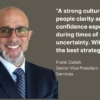The link of leadership, employee engagement and a company’s culture has never been greater. They need to be highly integrated and measurable, tied together by an organizations purpose, values and mission.
Why is this so critical? Businesses appear to be at a critical tipping point in their ability to maintain employee engagement over time. In a recent workforce study, less than half of the respondents agree that senior leaders have an interest in their well-being, and believe their direct supervisors have enough time to handle the people aspects of their jobs. When engagement starts to decline,companies become vulnerable not only to a measurable drop in productivity, but also to poorer customer service and greater rates of absenteeism and turnover.Employee engagement is not enough to give employers the sustained performance they need, or keep employees doing their work effectively in today’s pressured and fast-paced work environment. The root of the problem lies in gaps in two critical areas that have become essential to sustainable engagement.
The first gap effectively enabling workers with the right internal support, resources and tools. It develops as part of an organization’s culture and work environment, and must be created and continually nurtured through a focus on training, performance management, communication and visible leadership.
The second gap is creating an environment that’s energizing to work in because it promotes physical, emotional and social well-being.
In contrast to many of the more reward-oriented elements that affect attraction and retention, the drivers of sustainable engagement focus almost entirely on the culture and the relational aspects of the work experience. These include the nature, style and quality of organizational life, not the programs themselves. The impact of these drivers is felt through thousands of interactions – positive and negative, large and small – that play out daily across an organization. Some of those interactions are interpersonal and local – between employees and their direct managers or inside a small work team. Others affect everyone across the organization.
Top drivers of employee engagement look a bit different than five years ago. They are:
1. Leadership
- Is effective at growing the business
- Shows sincere interest in employees’ well-being
- Behaves consistently with the organization’s core values
- Earns employees’ trust and confidence
2. Stress, Balance and Workload
- Manageable stress levels at work
- A healthy balance between work and personal life
- Enough employees in the group to do the job right
- Flexible work arrangements
3. Goals and Objectives
- Employees understand:
- – The organization’s business goals
- – Steps they need to take to reach those goals
- – How their job contributes to achieving goals
4. Supervisors
- Assign tasks suited to employees’ skills
- Act in ways consistent with their words
- Coach employees to improve performance
- Treat employees with respect
5. Organizations Image
- Highly regarded by the general public
- Displays honesty and integrity in business activities









